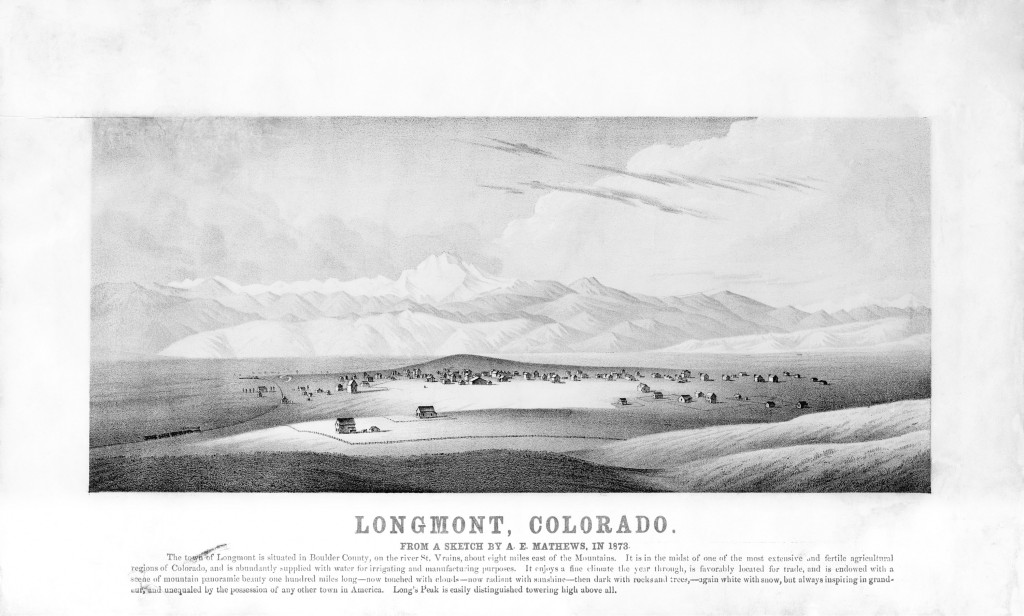Some Colorado towns began life as rough-and-tumble mining towns, some as forts, and some as outposts for farmers and ranchers. Very few were intentionally planned communities with orderly development goals, brought together by the glue of common vision – however, Longmont was one of the latter.
The economic depression after the Civil War, the completion of the transcontinental railroad, and public sentiment for “Manifest Destiny” made relocating to the West very attractive. Boosters of western settlement, like Horace Greeley (“go west young man”) encouraged many to seek better lives in the Colorado Territory.
The founders of the Chicago-Colorado Colony were inspired by that spirit. In late 1870 the original group of organizers met in Chicago to drum up enthusiasm for a bold project. Its purpose was to recruit members who “were temperate people of good moral character” to found a colony in Colorado. By January 1871 the wheels were literally turning as the committee rolled west to select a proper site for the colony. Who were these original organizers? They were men of substance – business, religious, and military leaders. If you know Longmont, you will recognize the names of the first officers: Collyer, Gay, Bross, Pratt, Bowen, Kimbark, and Emery.
When they arrived in Colorado, William Byers, owner of the Rocky Mountain News, escorted them around the Front Range to scout out the best site for their new colony. Byers also happened to be the agent for land sales for the new railroad linking Denver to the transcontinental Union Pacific Railroad in Cheyenne. After briefly being tempted by Greeley Colony, they decided on a small, bare hill across the St. Vrain River from the Town of Burlington. Most Burlington folks welcomed the colony. In fact, 75 of them bought memberships in the colony organization. Inspired by the impressive view of Longs Peak to the west, they named their new colony Longmont.
The colony, whose watch-words were “temperance, industry and morality,” attracted ambitious hard-working settlers. It had impressive organizational plans. Membership was limited to 1,000. Each member paid 150 dollars for his membership and was entitled to a five to 40 acre farm plot. An additional 25 to 50 dollars could buy a residential or business lot in town, but only one such purchase was allowed to each member. The founders were serious about the rules. Failure to make improvements to your parcel or being caught drinking alcohol could cost you your membership.
The townsite was platted by colony president, Seth Terry, a lumberman from Illinois. His industrious wife back in Illinois arranged to have his entire lumber inventory shipped by rail to the new colony. Buildings sprang up quickly. Town boundaries were Ninth Ave. on the north, First Avenue on the south, Bowen St. on the west and Martin St. on the east. By June 2, 1871 approximately 400 residents called Longmont home. Longmont was incorporated as a town on January 7, 1873, an amazingly short time from the arrival of the first colony members, proving that good organization, planning, and a common purpose can accomplish amazing results.
The years between 1871 and 1881 were difficult. Bringing a good water supply to the new town was one of many challenges. But Longmont had its guardian angel, Mrs. Elizabeth Thompson, a wealthy New York philanthropist. Not only did she buy 25 memberships to donate to help deserving folks start a better life, she also purchased an entire city block and built Colorado’s first public library. The Library Hall also housed the town hall, church, public school and community center. The colony celebrated Mrs. Thompson on June 15, 1871 by throwing the first Strawberry Festival, with lots of financial support from Mrs. Thompson herself.
Longmont still bears the legacy of its founders. It continues to attract new residents from Sweden, Germany, Russia, Mexico and Japan. We still celebrate Longmont’s diversity and fascinating history.

